| 1 | The official Jamaican boa |
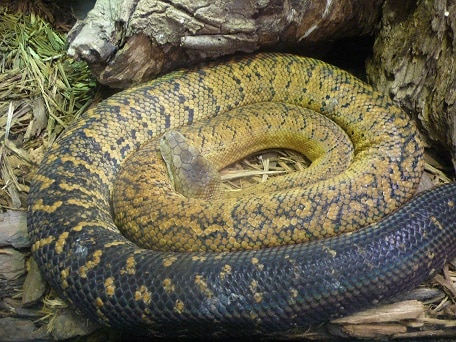
The Jamaican boa (Chilabothrus subflavus) is the largest snake on its namesake island, and an apex predator in its forests. This species lives exclusively on Jamaica, and has plummeted in population since Europeans first arrived 500 years ago. The colonisers slashed down the country’s ancient limestone forests, replacing them with vast sugar plantations, particularly from the 18th century onwards.
Compared to Cuban boas, Jamaican boas are much fussier about sticking to forest habitats, avoiding open hillsides and rarely appearing in towns. Consequently, they now occupy less than 10% of Jamaica, across 20 isolated pockets. They’re probably extinct on Great Goat Island to the south, although some hope that with their secretive nature, they’re clinging on better than people realise. Jamaican boas fundamentally dislike open spaces. If they’re in branches, it’s disguised by overlapping foliage, while if they’re on the ground, it’s in a rock crevice or tree trunk hollow.
This snake belongs to the Caribbean boa family, Chilabothrus, but is the sole member found on Jamaica, just as the Cuban boa is the sole member found on Cuba.
| 2 | Rarely leaves the forest |
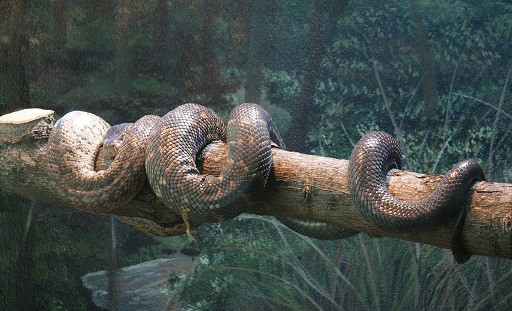
Jamaican boas are particularly common in forests with the tallest trees, with a dense canopy cover high above the floor. This is a semi-arboreal snake, often lurking in branches many metres above ground, but far from exclusively. They’re commonly found near swamps within forests, and this study found a strong correlation to vines, swinging from trees above, as well as trees with thicker diameter trunks.
Jamaican boas understand many secrets of the forest which humanity can barely comprehend. For example, they’ll sometimes identify root hollows between trees which gather huge pools of rainwater, and lap up the precious stored drink within, like a natural bowl. They like dense canopies, where they can travel between overlapping tree branches with ease.
Jamaican boas are slow slitherers, moving moderate distances per day. Males are more active, averaging at 18.60 metres daily in one study, versus 10.45 metres for females. Jamaican boas particularly like guango trees, resting comfortable in forks in the trunk.
| 3 | A yellow and black snake |
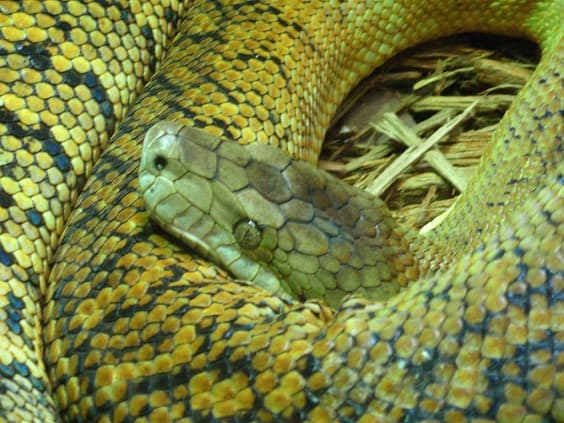
While some are duller, Jamaican boas are called “yellow snake” by locals because of their striking colour. This varies from clay orange to golden yellow, overlaid with ever shifting black spots and bands. These patterns increase as the tail approaches, with the yellow gradually being overwhelmed. Other patches have a purple, iridescent glow.
Jamaican boas almost look like a bronze sculpture, as they wait motionless in ambush. The yellow and black have endless combinations, with no Jamaican boa being quite alike. In some, the orange and black are so dense that the two contrast like a tiger’s stripes. No matter the colour, the gradual darkening toward the tail is always a consistent ID sign.
Jamaican boas have the typical crocodilian head shape of their kind, always with a hungry expression. However, their body is relatively thin for a boa, because of their tree-hugging lifestyle. This snake has a vertical pupil with a pale yellow iris.
| 4 | Killed by locals |
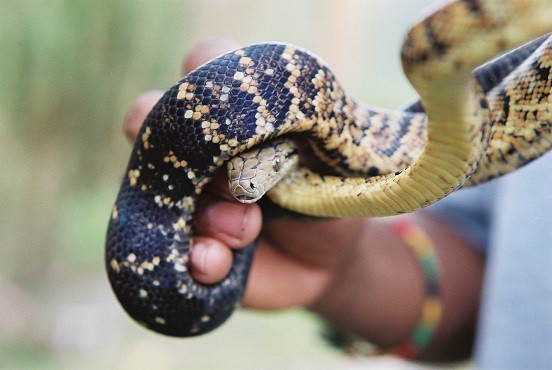
Jamaican boas can barely cope with agriculture or human encroachment at all. Forests are their place, whether in deep dark hollows at the centre, or the outskirts. The most ambitious Jamaican boas get is basking on a small country lane for several hours, before slithering off between tree roots again.
They also appear in banana plantations directly adjacent to forests, but this can be a death trap for them, as many farmers assume that all snakes are killers. Fear is so rampant that locals will slash Jamaican boas with machetes, pour rum over them and set them ablaze, or repeatedly run over the snake and reverse until all that remains is bloody mush.
In a 2010 study, coffee harvesters discovered a Jamaican boa directly above their head in the canopies, and the surveyors only just managed to convince the locals not to kill it. That said, humanity can actually help Jamaican boas in the right circumstances. If banana or coffee plantations are located in just the right spot, they can provide a bountiful food supply of rats, directly next door to a cosy forest habitat.
| 5 | Jamaican boas versus crows |
Jamaican villagers have a secret for finding this snake (which they call “yellow snake”): go to where crows are making the most noise. Jamaican boas are a heavy bird eater, and are locked in a perpetual power struggle with the Jamaican crow, a rare bird which numbers just 7000 worldwide yet is very common in Jamaica’s Cockpit country. Being one of its favourite prey, this bird has grown to recognise the Jamaican boa from long distances away. They’re always on the lookout for a flash of yellow scales, or a pair of vertical eyes, on a branch 5 metres above ground.
The crows alert their fellows with hoarse, agitated “caw” sounds, before rising off the branches and flying straight at the hopeful boa. The crows bombard the boa one by one, with their talons outstretched, constantly flapping and cawing, in order to convince the predator that no meal is worth this.
Sometimes, the crows spot the boa early, disguised by overlapping branches and foliage. Other times, they’re out on expeditions nearby and only spot the hungry snake when it’s inches away from the nest. These battles have also been observed on dark rooftops near forests. Being smaller is actually a positive, as it aids with disguise; a study found that larger Jamaican boas were more likely to be mobbed by crows.
| 6 | Ancient history |
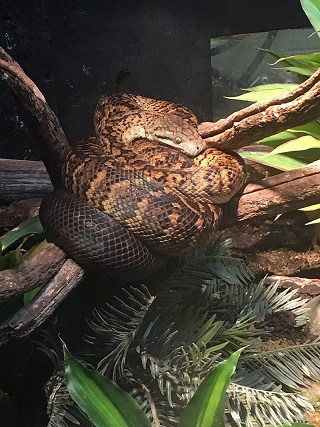
The Chilabothrus (Caribbean boa) family has 12-14 members. But Jamaican boas are most closely related to the Hatian vine boa and Haitian ground boa, having diverged 11.1 million years ago. They’re estimated to have diverged from the Cuban boa approximately 17.3 MYA.
The first man to officially to describe the Jamaican boa was Hans Sloane in 1725, naming it Serpent major subflavus. Sloane attempted to bring back a live Jamaican boa to England for study, but this went horribly wrong. After a few peaceful days onboard, the snake was shot by servants after it innocently slithered into their quarters. Meanwhile, a guana was frightened by seamen and fell into the ocean, while a crocodile died of unknown causes.
The Jamaican boa’s main hotspot today is Cockpit country, a rugged realm which sugar plantation slaves escaped to in the 18th century, forming a sanctuary. Cockpit country holds the largest continuous area of rainforest remaining in Jamaica today, and hundreds of small caves which are the namesake “cockpits”. Another surviving habitat is the Blue Mountains of Jamaica’s east, which are constantly shrouded in mist, with regular bands of rain and little sushine. Other surviving habitats include Portland Bight, Yallah Mountains, and Hellshire Hills.
| 7 | Lives well over 3 decades |
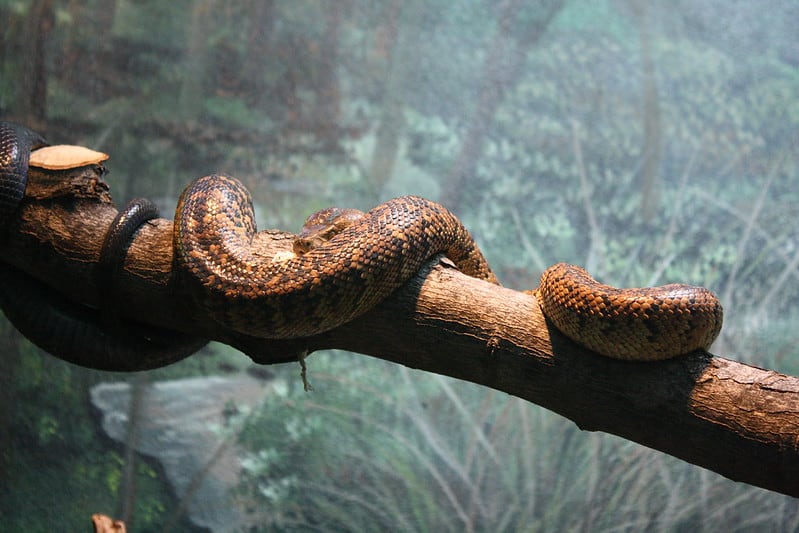
Jamaican boas are one of the longest Chilabothrus members living today. They don’t have the mammoth 7 metre logbook entries of the Cuban boa, but Jamaican boas surpass two metres with ease. A report from 1851 mentioned them reaching 10 feet, and the keeper of Port Morant Lighthouse (the oldest in Jamaica) mentioned killing a 9.5 feet boa, sometime from 1937 to 1939.
They’re also just as long-lived as other Caribbean boas. The median age in captivity is already 23.7 years, far outstripping the 8 years of a garter snake. The oldest captive male on record reached 38 years, and the oldest male breeding age was 30 years. The oldest female reached 31 years, and one female was still producing babies at age 23. This species lays live young like most boas, in wildly varying numbers of 3-34, one average being calculated at 18.45.
In captivity, they have a calm temperament, easy to feed with pinkie mice. However, things, don’t always go so swimmingly. Ohio Zoo was once introduced a male Jamaican boa to the cage of a female, hoping that the two would mate and kickstart a captive colony. Instead, the female ate the male.
| 8 | Tries to hunt bats |
Jamaican boas also attempt to hunt bats, like their cousin the Cuban boa, the king of bat-eating snakes. Jamaican boas are just as strong at climbing up stone cave walls, sometimes as high as 20 metres. They use a similar strategy: dangling down from cave roofs with their tail fastened, sometimes lowering two thirds of their body so that it swings like a vine. Then they wait for roosting bats to flock out for the night.
However, they seem to be a lot worse at actually grabbing the bats than the Cuban boa. For example, one female being observed in Windsor Great Cave hung from the ceiling, but failed to capture a single bat in 200 attempts. Windsor Great Cave lies in Cockpit country, western Jamaica, and is home to thousands of bats of 3 different species (including Macleay’s mustached bat), so there was plenty of opportunity.
Likewise, scientists at Ratbat hole, a mossy cave with a fanged entrance, saw boas attempting to hunt bats, but no success. In the records, it’s mostly juvenile Jamaican boas that attempt to hunt bats, with adults graduating to birds.
The Cuban and Jamaican boas belong to the same Chilabothrus family, diverging over 10 million years ago. Therefore, it’s possible that the bat-hunting skill originally appeared in their common ancestor, but strengthened in Cuban boas after they split off, while weakening in the Jamaican.
| 9 | Jamaican boa secrets |
In the early days of European exploration, frightened whispers leaked out of Jamaica that this snake was a voracious eater. Jamaican boas were supposedly found with 13 or 14 rats in their bellies at once. Even now, Jamaican boas will invade a chicken coop and gobble down 3 chickens at once, before being shooed off. Jamaican boas even eat chicken eggs. They swallow these whole, unlike the scarlet snake of the US, which cracks open the shells and slurps out the yolk.
Rather than a curse, a Jamaican boa setting up shop in your roof is a great blessing, as they naturally clear up rat infestations. Educators are now touring Jamaican schools and teaching the next generation which snakes are harmless and which aren’t, removing the inherited fear by letting the children handle rubber snakes.
Another reason for the decline was the introduction of 9 mongooses in 1872, which plantation owners hoped would gobble up the rat pests scurrying around. Instead, they bred and wreaked havoc on the local reptiles. Jamaican boas were already extremely rare by 1910, but have stabilised somewhat.
| 10 | The parrot wars |
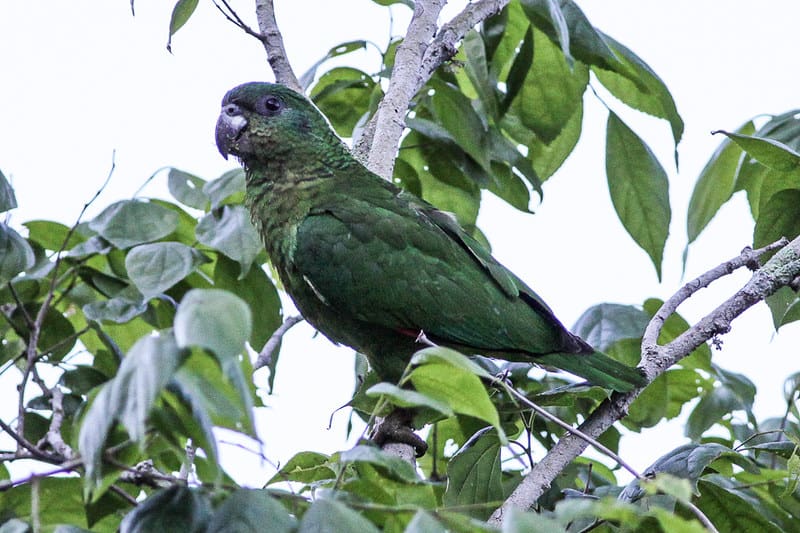
The balance of humanity and the Jamaican boa is always tilting precariously. Deforestation has hurt them, yet the mass invasion of rats disembarking from Atlantic ships has helped them. Studies find that black rats make up a large chunk of their prey, despite not being native to Jamaica. Norwegian rats (Rattus norvegicus) are also popular, while their native prey include Jamaican twig anoles, Jamaican crow, and Jamaican woodpeckers.
Mammals, reptiles and birds are all options for this gluttonous snake. Jamaican boas have a particular liking for parrots, including black-billed parrots (Amazona agilis) and yellow-billed parrots (Amazona collaria). In fact, a study found that their most active part of the year, March-July, coincided neatly with the breeding season for parrots.
Jamaican boas like to scoop birds directly out of nests, but sometimes get outsmarted. This parrot fledgling was spotted sitting directly on the boa’s back, after its two nest mates had already been devoured. Jamaican boas are an apex predator in their forests, and are the top cause of nest failure for some birds, particularly the yellow-billed parrot.